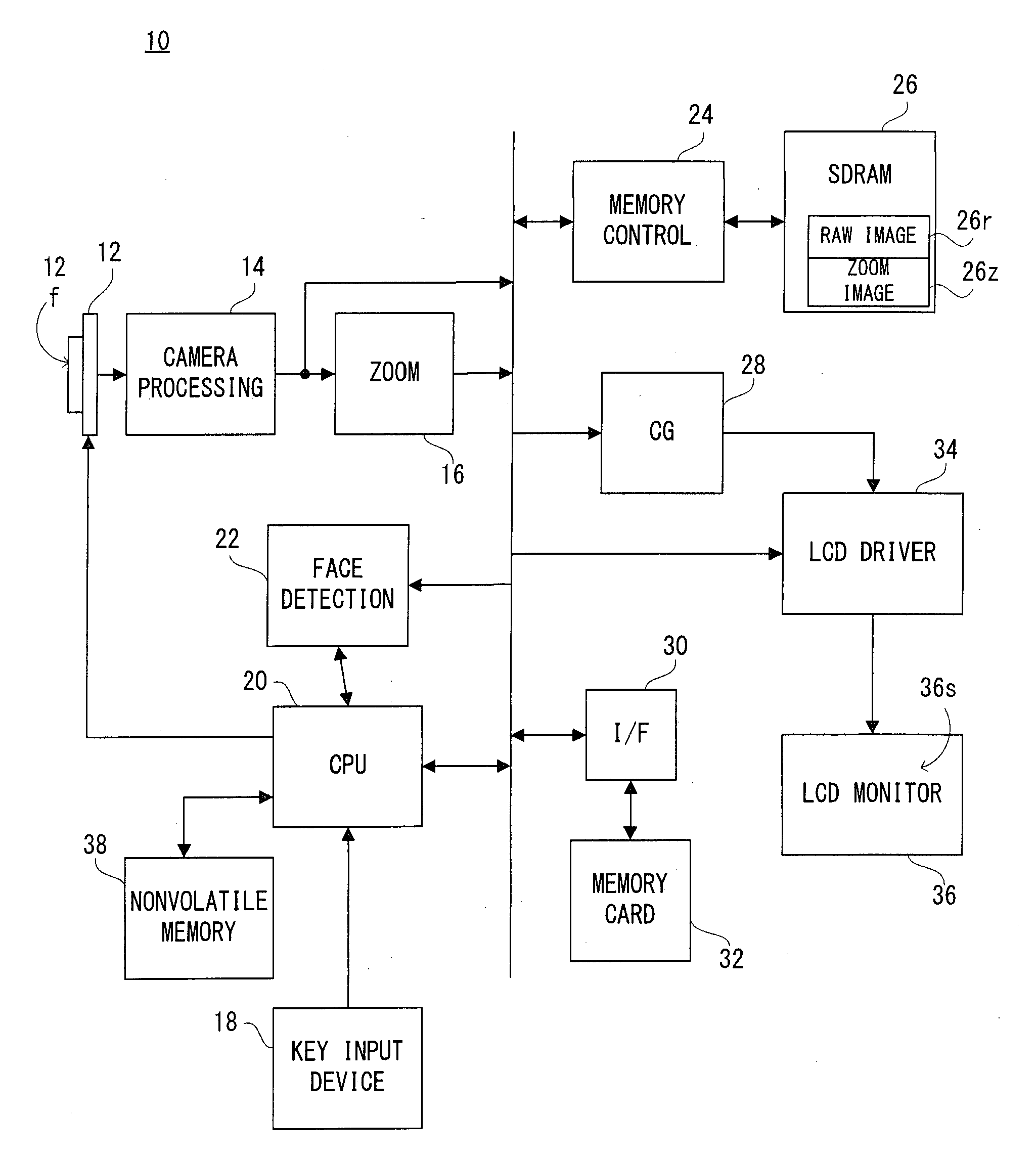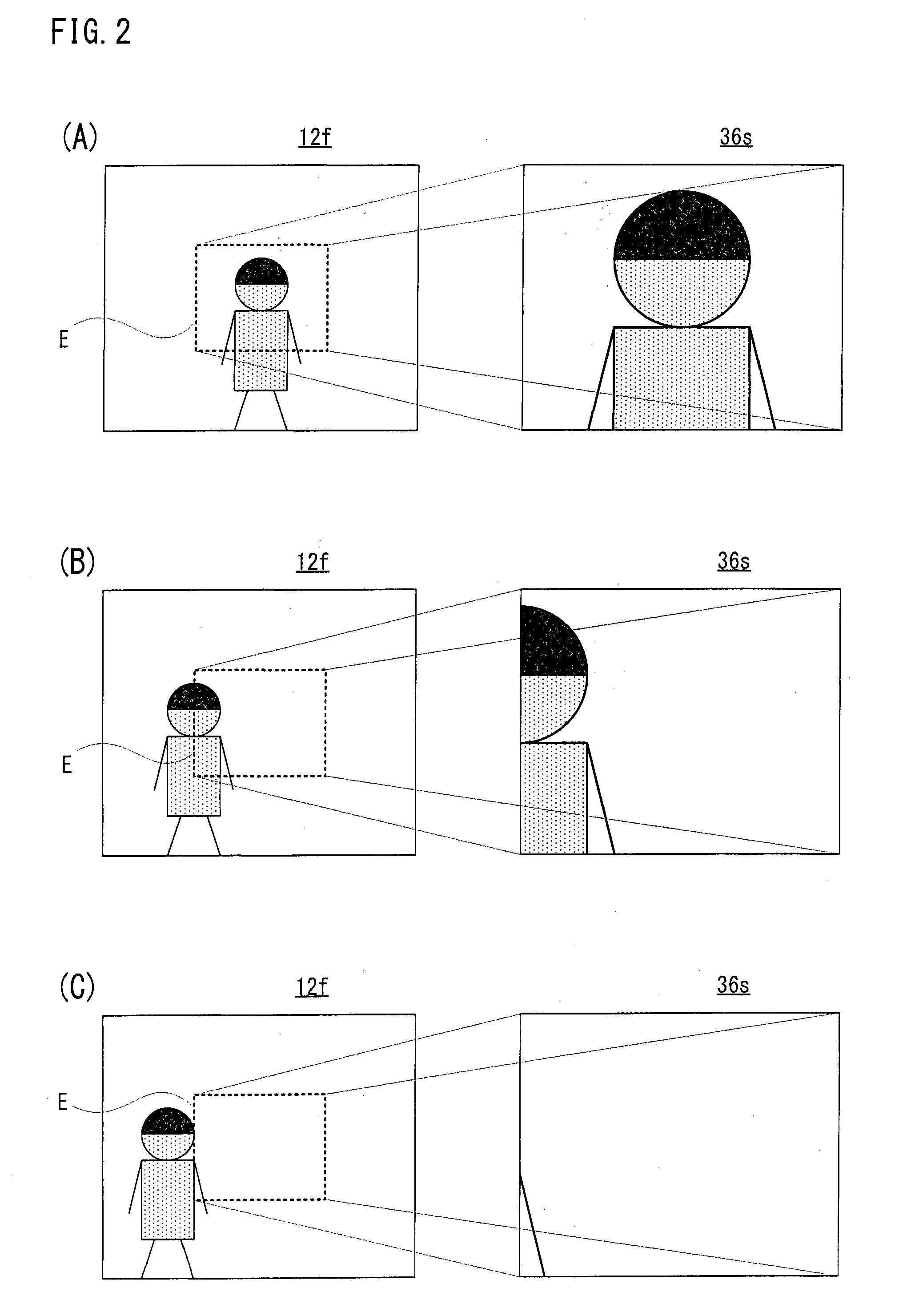Imaging device
a technology of a zoomer and a lens is applied in the field of imaging devices, which can solve the problems of difficult introduction and facial image lying off the zoom area, and achieve the effects of reducing processing, improving operability, and reducing the zoom magnification of the zoomer
- Summary
- Abstract
- Description
- Claims
- Application Information
AI Technical Summary
Benefits of technology
Problems solved by technology
Method used
Image
Examples
first embodiment
[0066]Referring to FIG. 1, a digital camera 10 of this embodiment includes an image sensor 12. An optical image of an object scene is irradiated onto the image sensor 12. An imaging area 12f of the image sensor 12 includes charge-coupled devices of 1600×1200 pixels, for example, and on the imaging area 12f, electric charges corresponding to the optical image of the object scene, that is, a raw image signal of 1600×1200 pixels is generated by a photoelectronic conversion.
[0067]When a power source is turned on, the CPU 20 instructs the image sensor 12 to repetitively execute a pre-exposure and a thinning-out reading in order to display a real-time motion image of the object, that is, a through-image on an LCD monitor 36. The image sensor 12 repetitively executes a pre-exposure and a thinning-out reading of the raw image signal thus generated in response to a vertical synchronization signal (Vsync) generated every 1 / 30 second. A raw image signal of 320×240 pixels corresponding to the o...
second embodiment
[0114]The configuration of this embodiment is the same or similar to that of the first embodiment, and therefore, the explanation is omitted by using FIG. 1 for help. The basic operation (normal mode) is also common, and the explanation therefor is omitted. The feature of this embodiment is in an “automatically following+cut-out position displaying mode”, but this mode is partially common to the “face position displaying mode 2” in the first embodiment, and the explanation in relation to the common part is omitted. Additionally, FIG. 1 and FIG. 11-FIG. 15 are referred below.
[0115]When the “automatically following+cut-out position displaying mode” is selected by the key input device 18, the mini-screen MS2 including the area symbol ES representing the position of the zoom area E is immediately displayed, and the display of the mini-screen MS2 is continued until another mode is selected. That is, in this mode, as shown in FIG. 11(A)-FIG. 11(C), the mini-screen MS2 is always displayed ...
third embodiment
[0130]The configuration of this embodiment is the same or similar to that of the first embodiment, and therefore, the explanation is omitted by using FIG. 1 for help. The basic operation (normal mode) is also common, and the explanation therefor is omitted. The feature in this embodiment is in a “face direction displaying mode”, but this mode is partially common to the “face position displaying mode 1” in the first embodiment, and therefore, the explanation in relation to the common part is omitted. Additionally, FIG. 1 and FIG. 16-FIG. 20 are referred below.
[0131]When the “face direction displaying mode” is selected by the key input device 18, in a case that the facial image which is being noted lies off the monitor screen 36s, an arrow Ar representing the direction in which the facial image exists is displayed on the monitor screen 36s as shown in FIG. 16(A)-FIG. 16(C).
[0132]More specifically, as shown in FIG. 17(A), the part except for the zoom area E of the object scene correspo...
PUM
 Login to View More
Login to View More Abstract
Description
Claims
Application Information
 Login to View More
Login to View More - R&D
- Intellectual Property
- Life Sciences
- Materials
- Tech Scout
- Unparalleled Data Quality
- Higher Quality Content
- 60% Fewer Hallucinations
Browse by: Latest US Patents, China's latest patents, Technical Efficacy Thesaurus, Application Domain, Technology Topic, Popular Technical Reports.
© 2025 PatSnap. All rights reserved.Legal|Privacy policy|Modern Slavery Act Transparency Statement|Sitemap|About US| Contact US: help@patsnap.com



